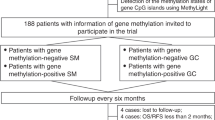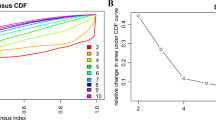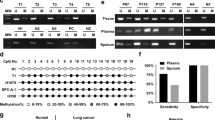Abstract
The present study examined the relationship between methylation of five genes (p16INK4a, RASSF1A, APC, RARβ and CDH13) and patient survival in 351 cases of surgically resected lung cancers. While there was no relationship between the other genes and survival, p16INK4a methylation was significantly related to unfavourable prognosis in lung adenocarcinomas.
Similar content being viewed by others
Main
Lung cancer is the leading cause of cancer deaths in the world. Human lung cancers are classified into two major histologic types, small-cell lung cancer (SCLC) and non-small-cell lung cancer (NSCLC), the latter consisting of several subtypes. Previously, squamous cell carcinoma was the predominant form of NSCLC, but in the last few decades it has been replaced by adenocarcinoma. Moreover, adenocarcinoma is the most common type of lung cancer in women, never smokers and young subjects.
Aberrant methylation of CpG islands in the promoter region of tumour suppressor genes (TSGs) and tumour-related genes has become established as the major mechanism for gene silencing (Baylin et al, 1998). Inactivation of TSGs by DNA methylation is regarded as one of the fundamental processes for the development of human malignant tumours, including lung cancers (Zochbauer-Muller et al, 2001). We studied the methylation status of five genes, p16INK4a, RASSF1A, APC, RARβ and CDH13, that are frequently methylated in lung cancers and that are considered to play an important role in the molecular pathogenesis of lung cancers (Toyooka et al, 2001b). We previously reported that smoke exposure, histologic type and geography-related differences in the methylation profiles of NSCLC (Toyooka et al, 2003). Some reports have described that methylation of specific TSGs are negative prognostic factors for lung cancer (Tang et al, 2000; Burbee et al, 2001). In this study, we collected the survival data of 351 cases of NSCLCs and correlated the methylation status of five genes (p16INK4a, RASSF1A, APC, RARβ and CDH13) with clinicopathological factors to investigate the effect of methylation of five genes on the survival of patients undergoing curative intent surgical resections for lung cancer.
Materials and methods
We studied frozen specimens of 351 tumours stored at −80°C obtained from Japanese patients with primary NSCLCs treated by curative intent surgical resection between 1993 and 2000 in our institutions. The patients consisted of 234 males and 117 females and their median age was 65 years. Most of the tumours (325, 93%) were adenocarcinomas (199, 57%) or squamous cell carcinomas (126, 36%), while the remainder consisted of 19 large-cell carcinomas, six adenosquamous cell carcinomas and one unclassified type. In all, 169 patients had stage I disease, 60 stage II, 122 stage III. A total of 252 patients (72%) were ever smokers with a median smoke exposure of 45.9 pack years and 99 never smokers. Institutional Review Board permission and informed consent were obtained at each collection site.
Genomic DNA was isolated from frozen tumour tissue by SDS/proteinase K (Life Technologies Inc., Rockville, MD, USA) digestion, phenol–chloroform extraction and ethanol precipitation. The methylation status of five genes reported to be frequently methylated and silenced in tumour but not in nonmalignant lung tissues (p16INK4a, RASSF1A, APC, RARβ and CDH13) (Toyooka et al, 2003, 2004) was determined by methylation-specific PCR (polymerase chain reaction) (MSP) assay using gene-specific primers (Herman et al, 1996; Cote et al, 1998; Tsuchiya et al, 2000; Burbee et al, 2001; Toyooka et al, 2001a). Briefly, 1 μg of genomic DNA was modified by sodium bisulphite, which converts all unmethylated cytosines to uracils residues while methylated cytosines remain unchanged. Polymerase chain reaction amplification was performed with sodium bisulphate-treated DNA as template as described previously (Herman et al, 1996). The MSP assays were sensitive enough to detect one methylated allele in the presence of 103–104 unmethylated alleles (Toyooka et al, 2003). DNA from peripheral blood lymphocytes and buccal mucosa brushes, each from 10 of nonsmoking healthy subjects, along with water blanks were used as negative controls for the methylated genes. DNA from lymphocytes healthy volunteer artificially methylated by treatment with Sss1 (New England BioLabs, Beverly, MA, USA) and then subjected to bisulphite treatment was used as a positive control for methylated alleles. Polymerase chain reaction products were visualised on 2% agarose gels stained with ethidium bromide. Results were confirmed by repeat MSP assays after an independently performed bisulphite treatment.
The overall survival was calculated from the date of surgery until the date of death or the last follow-up. Univariate analysis of overall survival was carried out by the Kaplan–Meier method using the log-rank test. Multivariate overall survival analysis was carried out by Cox's proportional-hazards model. The stepwise procedure was used to select independent variables with backward elimination method with P-values of entry of 0.10 and rejection of 0.12. All data were analysed with StatView for Windows (SAS Institute Inc., Cary, NC, USA).
Results
The rates of methylation of five genes were determined in 351 cases of NSCLCs. Aberrant methylation was detected in 86 (25%) of 351 cases for p16INK4a, 120 cases (34%) for RASSF1A, 131 cases (37%) for APC, 98 cases (28%) for RARβ and 104 cases (30%) for CDH13. We correlated the methylation status of five genes and clinicopathological factors including gender, age, smoking status, histological differentiation and TNM stage with prognosis for patient. The analysis was performed on all 351 cases, and the major histological subtypes adenocarcinomas and squamous cell carcinomas. As adenocarcinomas are the predominant form of lung cancer in never smokers, the percentage of adenocarcinoma patients who smoked (55%) is lower than the figure for the overall patient population (72%).
With regard to patient prognosis, there was no gene that was correlated with survival in all cases or squamous cell carcinomas. However, methylation of only one gene, p16INK4a, was associated with poor survival by Kaplan–Meier survival analysis (P=0.020) in adenocarcinoma (Table 1 a and Figure 1). The results of univariate and multivariate survival analysis for all variables are shown in Table 1a. Besides p16INK4a methylation, T stage (P=0.0002), lymph node status (P<0.0001) and disease stage (P<0.0001) were correlated with poor prognosis on univariate analysis (Table 1a). On multivariate analysis, p16INK4a methylation (RR=1.82, 95% CI=1.10–3.00, P=0.019), T stage (RR=1.87, 95% CI=1.20–2.92, P=0.006) and lymph node status (RR=4.60, 95% CI=3.00–7.05, P<0.0001) were independently associated with adverse prognosis. Since a previous study indicated that RASSF1A methylation was significantly related to poor prognosis in stage I adenocarcinoma (Tomizawa et al, 2002), we analysed our 105 cases of stage I adenocarcinoma (Table 1b). Of the variables, only p16INK4a methylation was significantly related to unfavourable survival by univariate and multivariate analysis in this cohort (RR=2.57, 95% CI=1.15–5.76, P=0.022). There was no relationship between RASSF1A methylation (P=0.22) and survival in stage I adenocarcinoma or in all cases of adenocarcinomas (P=0.16) (Figure 1).
Relationship between methylation status and patient survival by Kaplan–Meier method. (A) Survival curves by methylation status of p16INK4a in all cases. (B) Survival curves by methylation status of RASSF1A in all cases. (C) Survival curves by methylation status of p16INK4a in all adenocarcinoma cases. (D) Survival curves by methylation status of RASSF1A in all adenocarcinoma cases. The resulting curves were compared using log-rank test. M, methylated group; NM, not methylated group.
Discussion
Using newer molecular biology technologies, many studies for genetic abnormality of lung cancers have been investigated in cancer pathogenesis and for their effects on clinical outcome. Among the frequent genetic changes in lung cancer, abnormality of p53 or K-ras has been extensively studied (Fukuyama et al, 1997; Mitsudomi et al, 2000) including its significant association with prognosis. Studies on the relationship between epigenetic changes and patient outcome are of more recent origin. In our analysis, only p16INK4a methylation of the five genes that were frequently methylated in lung cancer was significantly correlated with poor prognosis in patients with lung adenocarcinoma. Furthermore, p16INK4a methylation, along with lymph node status and T stage, was an independent prognostic factor by multivariate analysis. The p16INK4a protein controls the transition from the G1 phase to the S phase in the cell cycle by inhibiting the phosphorylation of the retinoblastoma protein (Weinberg, 1995). Loss of p16INK4a expression is frequently observed in lung cancers (Kratzke et al, 1996), and while inactivation may occur by other mechanisms such as point mutations or homozygous deletions, aberrant methylation is the most frequent method. Our results are consistent with other reports that loss of p16INK4a expression was correlated with poor prognosis (Kratzke et al, 1996; Kawabuchi et al, 1999; Niklinski et al, 2001). In addition, Kim et al (2001) reported that p16INK4a methylation was a risk factor predicting shorter survival after surgery. Reports with regard to RASSF1A are more contradictory (Burbee et al, 2001; Tomizawa et al, 2002; Endoh et al, 2003). We have previously reported an association between RASSF1A methylation and poor survival in resected Australian NSCLC cases (Burbee et al, 2001). In our present much larger study from Japanese cases, we were unable to demonstrate a relationship between RASSF1A methylation and survival despite analysis of the various subgroups. With regard to this issue, Tomizawa et al (2002) pointed out that RASSF1A methylation was correlated with poor prognosis in NSCLC patients at stage I. On the other hand, Endoh et al (2003) reported that there was no correlation. Some of these differences may be due to geographic, stage, subtype or other variables.
Our study represents the largest study correlating methylation and prognosis in lung cancer, and confirms and extends previous reports that p16INK4a inactivation is a negative prognostic factor for NSCLC.
Change history
16 November 2011
This paper was modified 12 months after initial publication to switch to Creative Commons licence terms, as noted at publication
References
Baylin SB, Herman JG, Graff JR, Vertino PM, Issa JP (1998) Alterations in DNA methylation: a fundamental aspect of neoplasia. Adv Cancer Res 72: 141–196
Burbee DG, Forgacs E, Zochbauer-Muller S, Shivakumar L, Fong K, Gao B, Randle D, Kondo M, Virmani A, Bader S, Sekido Y, Latif F, Milchgrub S, Toyooka S, Gazdar AF, Lerman MI, Zabarovsky E, White M, Minna JD (2001) Epigenetic inactivation of RASSF1A in lung and breast cancers and malignant phenotype suppression. J Natl Cancer Inst 93: 691–699
Cote S, Sinnett D, Momparler RL (1998) Demethylation by 5-aza-2′-deoxycytidine of specific 5-methylcytosine sites in the promoter region of the retinoic acid receptor beta gene in human colon carcinoma cells. Anticancer Drugs 9: 743–750
Endoh H, Yatabe Y, Shimizu S, Tajima K, Kuwano H, Takahashi T, Mitsudomi T (2003) RASSF1A gene inactivation in non-small cell lung cancer and its clinical implication. Int J Cancer 106: 45–51
Fukuyama Y, Mitsudomi T, Sugio K, Ishida T, Akazawa K, Sugimachi K (1997) K-ras and p53 mutations are an independent unfavourable prognostic indicator in patients with non-small-cell lung cancer. Br J Cancer 75: 1125–1130
Herman JG, Graff JR, Myohanen S, Nelkin BD, Baylin SB (1996) Methylation-specific PCR: a novel PCR assay for methylation status of CpG islands. Proc Natl Acad Sci USA 93: 9821–9826
Kawabuchi B, Moriyama S, Hironaka M, Fujii T, Koike M, Moriyama H, Nishimura Y, Mizuno S, Fukayama M (1999) p16 inactivation in small-sized lung adenocarcinoma: its association with poor prognosis. Int J Cancer 84: 49–53
Kim DH, Nelson HH, Wiencke JK, Zheng S, Christiani DC, Wain JC, Mark EJ, Kelsey KT (2001) p16(INK4a) and histology-specific methylation of CpG islands by exposure to tobacco smoke in non-small cell lung cancer. Cancer Res 61: 3419–3424
Kratzke RA, Greatens TM, Rubins JB, Maddaus MA, Niewoehner DE, Niehans GA, Geradts J (1996) Rb and p16INK4a expression in resected non-small cell lung tumors. Cancer Res 56: 3415–3420
Mitsudomi T, Hamajima N, Ogawa M, Takahashi T (2000) Prognostic significance of p53 alterations in patients with non-small cell lung cancer: a meta-analysis. Clin Cancer Res 6: 4055–4063
Niklinski J, Niklinska W, Laudanski J, Chyczewska E, Chyczewski L (2001) Prognostic molecular markers in non-small cell lung cancer. Lung Cancer 34 (Suppl 2): S53–8
Tang X, Khuri FR, Lee JJ, Kemp BL, Liu D, Hong WK, Mao L (2000) Hypermethylation of the death-associated protein (DAP) kinase promoter and aggressiveness in stage I non-small-cell lung cancer. J Natl Cancer Inst 92: 1511–1516
Tomizawa Y, Kohno T, Kondo H, Otsuka A, Nishioka M, Niki T, Yamada T, Maeshima A, Yoshimura K, Saito R, Minna JD, Yokota J (2002) Clinicopathological significance of epigenetic inactivation of RASSF1A at 3p21.3 in stage I lung adenocarcinoma. Clin Cancer Res 8: 2362–2368
Toyooka KO, Toyooka S, Virmani AK, Sathyanarayana UG, Euhus DM, Gilcrease M, Minna JD, Gazdar AF (2001a) Loss of expression and aberrant methylation of the CDH13 (H-cadherin) gene in breast and lung carcinomas. Cancer Res 61: 4556–4560
Toyooka S, Maruyama R, Toyooka KO, McLerran D, Feng Z, Fukuyama Y, Virmani AK, Zochbauer-Muller S, Tsukuda K, Sugio K, Shimizu N, Shimizu K, Lee H, Chen CY, Fong KM, Gilcrease M, Roth JA, Minna JD, Gazdar AF (2003) Smoke exposure, histologic type and geography-related differences in the methylation profiles of non-small cell lung cancer. Int J Cancer 103: 153–160
Toyooka S, Suzuki M, Tsuda T, Toyooka KO, Maruyama R, Tsukuda K, Fukuyama Y, Iizasa T, Fujisawa T, Shimizu N, Minna JD, Gazdar AF (2004) Dose effect of smoking on aberrant methylation in non-small cell lung cancers. Int J Cancer 110: 462–464
Toyooka S, Toyooka OK, Maruyama R, Virmani AK, Girard L, Miyajima K, Harada k, Ariyoshi Y, Takahashi T, Sugio K, Brambilla E, Gilcrease M, Minna JD, Gazdar AF (2001b) DNA methylation profiles of lung tumors. Mol Cancer Ther 1: 61–67
Tsuchiya T, Tamura G, Sato K, Endoh Y, Sakata K, Jin Z, Motoyama T, Usuba O, Kimura W, Nishizuka S, Wilson KT, James SP, Yin J, Fleisher AS, Zou T, Silverberg SG, Kong D, Meltzer SJ (2000) Distinct methylation patterns of two APC gene promoters in normal and cancerous gastric epithelia. Oncogene 19: 3642–3646
Weinberg RA (1995) The retinoblastoma protein and cell cycle control. Cell 81: 323–330
Zochbauer-Muller S, Fong KM, Virmani AK, Geradts J, Gazdar AF, Minna JD (2001) Aberrant promoter methylation of multiple genes in non-small cell lung cancers. Cancer Res 61: 249–255
Acknowledgements
This work was supported by grants from the UT Specialised Program of Research Excellence in Lung Cancer (P50CA70907) and the Early Detection Research Network (5U01CA8497102), National Cancer Institute, Bethesda, MD, USA.
Author information
Authors and Affiliations
Corresponding author
Rights and permissions
From twelve months after its original publication, this work is licensed under the Creative Commons Attribution-NonCommercial-Share Alike 3.0 Unported License. To view a copy of this license, visit http://creativecommons.org/licenses/by-nc-sa/3.0/
About this article
Cite this article
Toyooka, S., Suzuki, M., Maruyama, R. et al. The relationship between aberrant methylation and survival in non-small-cell lung cancers. Br J Cancer 91, 771–774 (2004). https://doi.org/10.1038/sj.bjc.6602013
Received:
Revised:
Accepted:
Published:
Issue Date:
DOI: https://doi.org/10.1038/sj.bjc.6602013
Keywords
This article is cited by
-
Expression level and methylation status of three tumor suppressor genes, DLEC1, ITGA9 and MLH1, in non-small cell lung cancer
Medical Oncology (2016)
-
Targeting Chromatin-Mediated Transcriptional Control of Gene Expression in Non-Small Cell Lung Cancer Therapy: Preclinical Rationale and Clinical Results
Drugs (2015)
-
Assessment of methylation status of locoregional lymph nodes in lung cancer using EBUS-NA
Clinical & Experimental Metastasis (2015)
-
Clinico-epigenetic combination including quantitative methylation value of DKK3 augments survival prediction of the patient with cervical cancer
Journal of Cancer Research and Clinical Oncology (2013)
-
Lung cancer: From single-gene methylation to methylome profiling
Cancer and Metastasis Reviews (2010)




